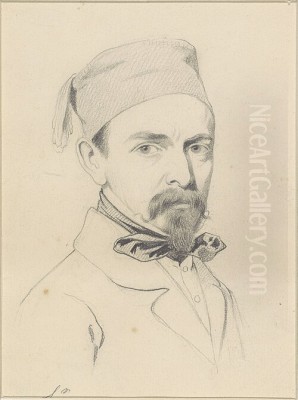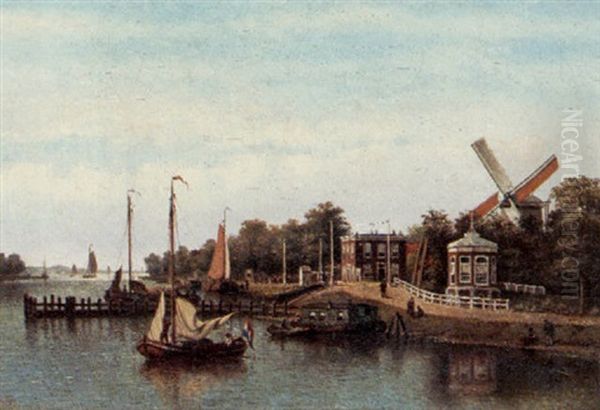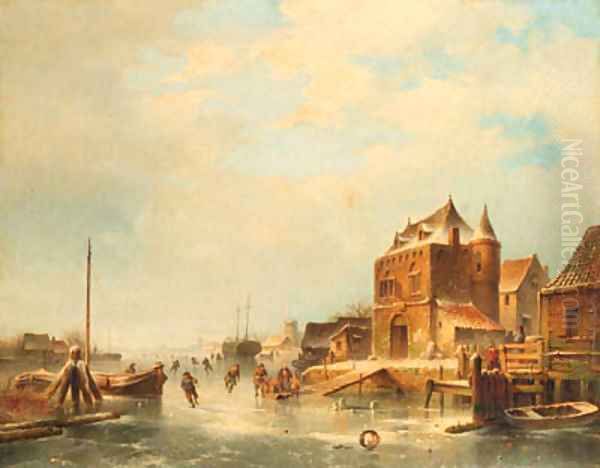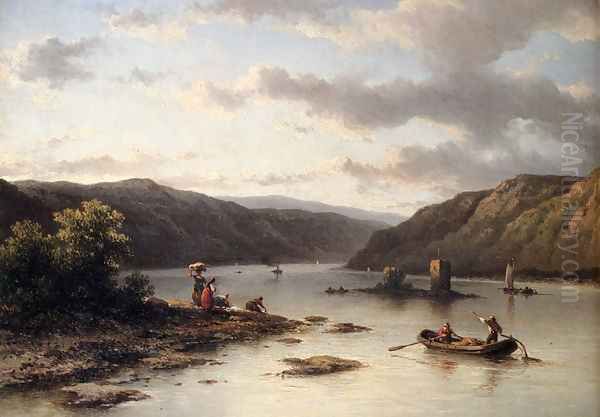
Johannes Hilverdink stands as a significant, albeit sometimes overlooked, figure within the rich tapestry of nineteenth-century Dutch art. Born in Groningen on January 18, 1813, and passing away in Amsterdam on October 1, 1902, his long life spanned a crucial period of artistic transition in the Netherlands. He emerged as a versatile and prolific artist associated primarily with the Dutch Romantic movement, mastering various mediums including oil painting, watercolor, lithography, drawing, and pastel. His work predominantly features landscapes, seascapes, and city views, capturing the essence of the Dutch environment while also reflecting his experiences abroad.
Hilverdink's contribution extends beyond his canvases; he was an active member of the Amsterdam art community, affiliated with prestigious institutions and recognized for his talents both domestically and internationally. Despite not achieving widespread fame during his peak creative years, his dedication to his craft and the quality of his output secured him a lasting place in Dutch art history. His legacy is one of technical skill, romantic sensibility, and a deep engagement with the visual motifs of his time.
Early Life and Artistic Formation
Johannes Hilverdink's entry into the world was marked by a connection to the performing arts. He was born in Groningen to Jacobus Hilverdink and Anna Maria Corver, both actors. This familial link to the arts was strong; his family included other notable figures from the Dutch stage, such as the famous actor Marten Corver, who was related through his mother's side (sources vary on the exact relationship, sometimes citing Marten Corver as a grandparent or the father-in-law of his teacher Barend Cornelis Koekkoek). This environment likely fostered an early appreciation for creative expression, even if young Johannes chose the visual rather than the performing arts.

His formal artistic training took place in Amsterdam, the vibrant heart of the Dutch art world. He enrolled at the prestigious Royal Academy of Visual Arts (Koninklijke Academie van Beeldende Kunsten), a central institution for aspiring artists. Here, he received instruction from prominent figures who would shape his development. Among his teachers were Jan Willem Pieneman (1779-1853), a renowned painter of historical scenes and portraits and a director of the Academy, known for works like The Battle of Waterloo.
Another influential instructor was Jean Auguste Daiwaille (1786-1850), noted for his portraiture and pioneering work in lithography in the Netherlands. Perhaps most significantly, Hilverdink studied under Barend Cornelis Koekkoek (1803-1862), widely regarded as the leading landscape painter of Dutch Romanticism. Koekkoek's meticulously detailed and often idealized depictions of forests and winter scenes set a high standard for landscape art. Studying under such masters provided Hilverdink with a solid technical foundation and exposed him to the prevailing artistic currents of the era, particularly the burgeoning Romantic movement.
Embracing the Romantic Vision
Johannes Hilverdink began his artistic career around 1828, fully embracing the tenets of Romanticism that were gaining prominence across Europe and finding a distinct expression in the Netherlands. Dutch Romanticism, while sharing broader European themes like the awe-inspiring power of nature and a fascination with the past, often retained a characteristic Dutch affinity for detailed observation and depictions of the local environment, albeit infused with heightened atmosphere and emotion. Hilverdink's work fits comfortably within this framework.
His chosen subjects were typical of the Romantic sensibility: expansive landscapes, dramatic seascapes often featuring naval vessels or coastal activities, tranquil river views, and picturesque mountain scenes inspired by his travels. He also dedicated considerable attention to urban environments, painting detailed cityscapes that captured the architectural character of Dutch towns, as well as evocative church interiors, a genre with deep roots in Dutch art history reaching back to the Golden Age painters like Pieter Saenredam and Emanuel de Witte.
Hilverdink's Romanticism was expressed through careful composition, attention to atmospheric effects like light and weather, and a desire to convey a specific mood, whether it be the tranquility of a rural scene, the dynamism of the sea, or the quiet solemnity of a church. While perhaps less overtly dramatic than some German or British Romantics, his work consistently displays a sensitivity to the picturesque and an appreciation for the beauty found in both nature and human environments. His travels outside the Netherlands, including trips to Belgium, Germany, France, England, and even Greenland, further broadened his visual repertoire and introduced different types of landscapes and light into his work.
Mastery Across Mediums

A defining characteristic of Johannes Hilverdink's artistic practice was his remarkable versatility across different mediums. While accomplished in oil painting, the traditional high-status medium, he was equally adept at watercolor, lithography, drawing, and pastel. This multi-faceted approach allowed him to explore different aesthetic effects and reach diverse audiences. His skill as a draftsman underpinned all his work, evident in the clear structure and detail found in his paintings and prints.
His proficiency in watercolor was particularly notable. This medium, prized for its transparency and luminosity, was well-suited to capturing fleeting effects of light and atmosphere, making it ideal for landscapes and topographical views. A significant project showcasing his watercolor skills was the series of 24 views of Dutch cities and harbours he created in collaboration with, or for, the marine painter Everhardus Koster (1817-1892). These works served not only as artistic representations but also as valuable visual documents of the Netherlands' urban and maritime infrastructure in the mid-nineteenth century.
Lithography, a printmaking technique that gained popularity in the 19th century, was another area where Hilverdink applied his talents. Lithography allowed for wider dissemination of images than unique paintings or drawings, making art more accessible. His engagement with graphic arts demonstrates his awareness of contemporary technological developments and markets. Whether working in oil, watercolor, or print, Hilverdink consistently displayed a high level of technical competence and an ability to adapt his style effectively to the demands of each medium.
Landscapes and Seascapes: Capturing the Dutch Spirit
Landscapes and seascapes formed the core of Johannes Hilverdink's oeuvre, reflecting the enduring Dutch fascination with the surrounding environment. His landscapes often depict the flat, water-rich countryside of the Netherlands, featuring windmills, canals, and rural dwellings under expansive skies. He captured the changing seasons, with particular attention to the atmospheric conditions that define the Dutch climate. While influenced by the idealized approach of his teacher B.C. Koekkoek, Hilverdink's landscapes often possess a directness and a specific sense of place.
His seascapes continued a strong tradition in Dutch art. He painted coastal scenes with fishing boats, bustling harbour views, and more open sea compositions, sometimes featuring naval ships which added a touch of national pride or historical resonance. These works demonstrate his understanding of maritime life and his ability to render the complex interplay of water, light, and vessels. His travels likely enriched his marine painting, exposing him to different coastlines and maritime conditions, from the North Sea shores to potentially more dramatic vistas encountered abroad, such as his documented travels which included Greenland.

In the context of Dutch Romantic landscape painting, Hilverdink's work can be seen alongside that of contemporaries like Andreas Schelfhout (1787-1870), a master of winter landscapes and coastal scenes whose influence was pervasive, and Wijnand Nuijen (1813-1839), a highly talented Romantic painter whose promising career was cut short. Hilverdink carved out his own niche through his consistent production and the breadth of his landscape subjects, contributing significantly to the visual record of the Netherlands and its relationship with water and land during the 19th century.
Urban Scenes and Architectural Views
Beyond the natural world, Johannes Hilverdink demonstrated a keen interest in depicting the built environment. His cityscapes offer valuable glimpses into nineteenth-century Dutch urban life and architecture. He painted views of Amsterdam and other towns, focusing on characteristic streets, canals, bridges, and public squares. These works often combine topographical accuracy with an atmospheric rendering of light and daily activity, situating them within a tradition of Dutch townscape painting that was being revitalized in the Romantic era.
One notable example is his painting Haarlemmersluis (1858), depicting a well-known lock and bridge area in Amsterdam. Such works captured the unique blend of water and architecture that defines many Dutch cities. Another significant urban subject he tackled was the Jewish quarter of Amsterdam. His painting Jodenbreestraat (circa 1860), possibly created in collaboration with Eduard A. Hilverdink (likely his son), provides a view of this historic neighbourhood. This subject matter was also explored by contemporaries like Pieter Vertin (1813-1893) with his Winterdag in de Jodenbuurt (1877) and the French illustrator Charles Lapante with In de Jodenbuurt (1879), as well as the Dutch Jewish artist Salomon Verveer (1813-1876), indicating a contemporary interest in documenting this specific urban milieu.
Hilverdink also excelled in painting church interiors, a genre mastered by artists like Johannes Bosboom (1817-1891), who later became a key figure in the Hague School. Hilverdink's interiors capture the grandeur, light, and shadow within these sacred spaces, continuing a dialogue with the celebrated church painters of the Dutch Golden Age. His illustration of De Sint-Anthony Waag in Amsterdam further demonstrates his engagement with significant historical buildings. Compared to the leading townscape specialist Cornelis Springer (1817-1891), known for his sunnier and meticulously detailed views, Hilverdink's urban scenes might offer a different, perhaps sometimes more atmospheric or everyday perspective.
Professional Life, Affiliations, and Recognition
Johannes Hilverdink was an active participant in the professional art world of Amsterdam. His association with the Royal Academy of Visual Arts began as a student and culminated in his membership from 1852 onwards. This affiliation placed him within the central institution governing artistic education and standards in the city. Furthermore, in 1846, he became a member of the prestigious artists' society Arti et Amicitiae ("Art and Friendship") in Amsterdam. Membership in Arti was crucial for artists, providing exhibition opportunities, networking, and a platform for engaging with peers and patrons.
His standing in the art community was further solidified by official recognition. He was awarded the Knight's Cross of the Order of the Oak Crown by the Grand Duchy of Luxembourg, an honour bestowed upon individuals for outstanding achievements in various fields, including the arts. This international recognition speaks to the reach and appreciation of his work beyond the borders of the Netherlands. He exhibited his works regularly, contributing to the artistic life of his time.
Despite these affiliations and honours, sources suggest that Hilverdink did not achieve the same level of widespread fame or financial success as some of his contemporaries during his lifetime. Figures like B.C. Koekkoek or Cornelis Springer commanded higher prices and greater public acclaim. Nevertheless, Hilverdink maintained a steady and respected career, producing a substantial body of work. His paintings were acquired by collectors and eventually found their way into museum collections, ensuring his contribution was not forgotten. The later appreciation of his work reflects a pattern often seen in art history, where an artist's true significance becomes clearer with the passage of time.
Collaborations and Artistic Milieu
The nineteenth-century Dutch art world was a relatively interconnected community, and Johannes Hilverdink participated in this network through collaborations and interactions with fellow artists. His most documented collaboration was with Everhardus Koster on the series of 24 watercolors depicting Dutch cities and ports. Koster himself was a respected painter, particularly known for his marine and river scenes, making him a logical partner for such a project. This collaboration highlights the way artists sometimes pooled their talents for specific commissions or shared interests.
The mention of a potential collaboration with Eduard A. Hilverdink on the Jodenbreestraat painting points to familial artistic connections. It was common for artistic skills to be passed down within families, and Johannes' son, Eduard Alexander Hilverdink, also became a painter, continuing the family's artistic pursuits. This suggests a supportive environment where artistic knowledge and perhaps even joint work occurred within the Hilverdink household.
Hilverdink worked during a period rich with artistic talent in the Netherlands. Besides his teachers and collaborators, he was contemporary with a diverse group of artists. These included landscape painters like Schelfhout, figure and genre painters like Hendrik Jacobus Scholten (1824-1907), historical painters such as Charles Rochussen (1814-1894) and Nicolaas Pieneman (1809-1860, son of his teacher Jan Willem), and other cityscape painters like Kaspar Karsen (1810-1896). He would have encountered these artists at the Royal Academy, Arti et Amicitiae exhibitions, and galleries. While direct competitive rivalries are not heavily documented, he inevitably operated within this field, his work being seen and implicitly compared alongside that of his peers.
Later Years and Enduring Legacy
Johannes Hilverdink continued to live and work in Amsterdam throughout his long life, remaining active as an artist for many decades. He witnessed significant changes in the Dutch art scene, including the decline of Romanticism and the rise of Realism and the Hague School in the latter half of the 19th century. While his own style remained rooted in the Romantic tradition he had mastered early in his career, his sustained production ensured a continuous presence. He passed away in Amsterdam in 1902 at the age of 89.
Although contemporary fame might have been moderate compared to the very top tier of Dutch Romantics, Hilverdink's legacy is secured by the quality, quantity, and diversity of his work. His paintings, drawings, and prints are held in various public and private collections, including Dutch museums, where they are valued for their artistic merit and as historical documents. His depictions of Dutch landscapes, seascapes, and cityscapes contribute significantly to our understanding of the Netherlands in the 19th century.
His versatility across mediums, from oil painting to watercolor and lithography, marks him as a thoroughly skilled and adaptable artist. His role as a student of major figures like Pieneman and Koekkoek, and his subsequent career as a member of key institutions like the Royal Academy and Arti et Amicitiae, place him firmly within the mainstream of Dutch art history of his period. The continuation of the artistic tradition through his son Eduard Alexander Hilverdink adds another dimension to his legacy. Johannes Hilverdink remains an important representative of Dutch Romanticism, an artist whose dedication to capturing the multifaceted beauty of his world left behind a rich and enduring body of work.